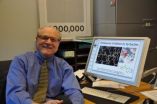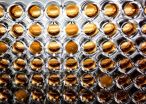(Press-News.org) RIVERSIDE, Calif. — Chemists at the University of California, Riverside have developed a compound that holds much promise in the laboratory in fighting renal (kidney) cancer.
Named TIR-199, the compound targets the "proteasome," a cellular complex in kidney cancer cells, similar to the way the drug bortezomib, approved by the Food and Drug Administration, targets and inhibits the proteasome in multiple myeloma cells, a cancer coming from bone marrow.
Michael Pirrung, a distinguished professor of chemistry at UC Riverside, announced the development of TIR-199 in a lecture he gave on Feb. 19 at the 5th International Conference on Drug Discovery and Therapy, held in Dubai, UAE.
Operating like the garbage dump of a cell, the proteasome breaks down proteins. Drugs that block the action of proteasomes are called proteasome inhibitors, and have been shown to have activity against a variety of cancer cell lines, albeit with mixed results. For example, bortezomib, though effective against multiple myeloma, has many side effects because cells other than bone marrow cells are affected.
"The novel feature of our new proteasome inhibitor, TIR-199, is that it is nearly as potent as bortezomib, but is selective in inhibiting the growth of only renal cancer cell lines," Pirrung said. "It's what makes TIR-199 attractive."
The TIR-199 research project at UC Riverside began about four years ago after a multidisciplinary, international team reported on a class of compounds that act on the proteasome. These compounds are the "syringolin" natural products — such as a compound produced naturally by the wheat-infecting bacterium Pseudomonas syringae. TIR-199 is a synthetic relative of syringolin.
"At UCR we began to work on, and completed the synthesis of, two compounds from this class of compounds," Pirrung said. "Of the two, TIR-199 showed most promise."
Pirrung's lab first shipped TIR-199 samples to the University of Hawaii, Hilo, where André Bachmann, an associate professor of pharmaceutical sciences and Pirrung's collaborator, studied TIR-199 in test-tube assays for how it worked against the proteasome. Bachmann then tested the compound against a limited number of cancer cell lines that showed that TIR-199 was effective against the cancer cells. What remained unclear, however, was if TIR-199 was toxic to normal cells.
Encouraged by these results, Pirrung submitted TIR-199 samples to the National Cancer Institute at the National Institutes of Health, where the compound was subjected to a rigorous 60-cell screening used routinely to test compounds for their effectiveness in battling 60 kinds of cancer, including leukemia, lung, colon, brain, breast, ovarian prostate and renal cancers.
"We were very excited when the NCI informed us that TIR-199 has excellent potential to be moved to drug development because of its selective activity against renal cancer," Pirrung said. "This is good news also because the NCI scientists told us there really are no good drugs out there to fight renal cancer."
Next, the NCI will test TIR-199 on cells grown in a hollow fiber that partially mimics the body by offering a three-dimensional environment. If the test results are positive, TIR-199 will be tested on mice.
The UCR Office of Technology Commercialization has filed a patent application on TIR-199 and is currently seeking partners in industry interested in developing the compound commercially. Several biotechnology companies have already shown interest.
"We still have to fine-tune TIR-199 in the lab because some aspects — certain structural elements within it — make it easily metabolized," Pirrung said. "But now that we have a good handle on how structural changes in the compound affect anticancer activity and how the parent drug binds to the proteasome, we are pretty confident of making a better version — the second generation — of TIR-199."
INFORMATION:
The project was funded by a grant from the University of California Institute for Mexico and the United States (UC MEXUS), to Tannya Ibarra-Rivera, a former postdoctoral researcher in Pirrung's lab who helped discover TIR-199 and after whose initials the compound is named; and to Pirrung from the UC Cancer Research Coordinating Committee.
The University of California, Riverside is a doctoral research university, a living laboratory for groundbreaking exploration of issues critical to Inland Southern California, the state and communities around the world. Reflecting California's diverse culture, UCR's enrollment has exceeded 21,000 students. The campus will open a medical school in 2013 and has reached the heart of the Coachella Valley by way of the UCR Palm Desert Center. The campus has an annual statewide economic impact of more than $1 billion. A broadcast studio with fiber cable to the AT&T Hollywood hub is available for live or taped interviews. UCR also has ISDN for radio interviews. To learn more, call (951) UCR-NEWS.
New compound holds high promise in battling kidney cancer
UC Riverside's Michael Pirrung announces development of TIR-199 at conference in Dubai
2013-02-20
ELSE PRESS RELEASES FROM THIS DATE:
Diagnosis and treatment now possible for osteoarthritic cats
2013-02-20
VIDEO:
Scientists at the University of Montreal's Quebec Research Group in Animal Pharmacology have found a way to recognize and treat osteoarthritis in cats -- a condition that the owner might...
Click here for more information.
Scientists at the University of Montreal's Quebec Research Group in Animal Pharmacology have found a way to recognize and treat osteoarthritis in cats – a condition that the owner might not notice and that can make even petting painful. "Osteoarthritis ...
Stanford researchers develop tool for reading the minds of mice
2013-02-20
If you want to read a mouse's mind, it takes some fluorescent protein and a tiny microscope implanted in the rodent's head.
Stanford scientists have demonstrated a technique for observing hundreds of neurons firing in the brain of a live mouse, in real time, and have linked that activity to long-term information storage. The unprecedented work could provide a useful tool for studying new therapies for neurodegenerative diseases such as Alzheimer's.
The researchers first used a gene therapy approach to cause the mouse's neurons to express a green fluorescent protein ...
That's the way the droplets adhere
2013-02-20
CAMBRIDGE, MA -- Understanding exactly how droplets and bubbles stick to surfaces — everything from dew on blades of grass to the water droplets that form on condensing coils after steam drives a turbine in a power plant — is a "100-year-old problem" that has eluded experimental answers, says MIT's Kripa Varanasi. Furthermore, it's a question with implications for everything from how to improve power-plant efficiency to how to reduce fogging on windshields.
Now this longstanding problem has finally been licked, Varanasi says, in research he conducted with graduate student ...
Artful science
2013-02-20
There are "things hidden in plain sight" all around us. But art can help students see their world anew, unlocking discoveries in fields ranging from plant biology to biomedical imaging, according to University of Delaware professor John Jungck.
Jungck's sentiments were echoed by a panel of experts speaking on "Artful Science" on Feb. 15 at the annual meeting of the American Association for the Advancement of Science (AAAS) in Boston. Jungck organized the panel and also spoke at the event.
Canoeing on a lake near his home in northwestern Minnesota when he was a youngster, ...
Powerful people are looking out for their future selves
2013-02-20
Would you prefer $120 today or $154 in one year? Your answer may depend on how powerful you feel, according to new research in Psychological Science, a journal of the Association for Psychological Science.
Many people tend to forego the larger reward and opt for the $120 now, a phenomenon known as temporal discounting. But research conducted by Priyanka Joshi and Nathanael Fast of the University of Southern California Marshall School of Business suggests that people who feel powerful are more likely to wait for the bigger reward, in part because they feel a stronger connection ...
Engineering control theory helps create dynamic brain models
2013-02-20
BOSTON -- Models of the human brain, patterned on engineering control theory, may some day help researchers control such neurological diseases as epilepsy, Parkinson's and migraines, according to a Penn State researcher who is using mathematical models of neuron networks from which more complex brain models emerge.
"The dual concepts of observability and controlability have been considered one of the most important developments in mathematics of the 20th century," said Steven J. Schiff, the Brush Chair Professor of Engineering and director of the Penn State Center for ...
New approach alters malaria maps
2013-02-20
UNIVERSITY PARK, Pa. – Identifying areas of malarial infection risk depends more on daily temperature variation than on the average monthly temperatures, according to a team of researchers, who believe that their results may also apply to environmentally temperature-dependent organisms other than the malaria parasite.
"Temperature is a key driver of several of the essential mosquito and parasite life history traits that combine to determine transmission intensity, including mosquito development rate, biting rate, development rate and survival of the parasite within the ...
Mutant champions save imperiled species from almost-certain extinction
2013-02-20
Species facing widespread and rapid environmental changes can sometimes evolve quickly enough to dodge the extinction bullet. Populations of disease-causing bacteria evolve, for example, as doctors flood their "environment," the human body, with antibiotics. Insects, animals and plants can make evolutionary adaptations in response to pesticides, heavy metals and overfishing.
Previous studies have shown that the more gradual the change, the better the chances for "evolutionary rescue" – the process of mutations occurring fast enough to allow a population to avoid extinction ...
NASA saw Tropical Storm Haruna come together
2013-02-20
Tropical Storm Haruna came together on Feb. 19 in the Southern Indian Ocean and two NASA satellites provided visible and infrared imagery that helped forecasters see the system's organization.
A low pressure area called System 94S developed on Friday, Feb. 15 in the northern Mozambique Channel. Over the course of four days System 94S became more organized and by Feb. 19 it became Tropical Storm Haruna.
On Tuesday, Feb. 19, Tropical Storm Haruna had maximum sustained winds near 35 knots (40.2 mph/64.8 kph). Haruna was located in the Mozambique Channel, near 21.4 south ...
NASA satellite sees Tropical Depression 02W soak the Philippines
2013-02-20
The second tropical depression of the northwestern Pacific Ocean season formed on Feb. 19, and NASA's Aqua satellite showed the storm was soaking the central and southern Philippines.
NASA's Aqua satellite passed over Tropical Depression 02W (TD02W) as it was coming together and soaking provinces in Mindanao and the Palawan province of Luzon. The Atmospheric Infrared Sounder (AIRS) instrument that flies aboard Aqua captured an infrared image of the depression at 0541 UTC (12:41 a.m. EST). The AIRS image showed very cold cloud top temperatures, colder than -63F (-52C) ...
LAST 30 PRESS RELEASES:
Injectable breast ‘implant’ offers alternative to traditional surgeries
Neuroscientists devise formulas to measure multilingualism
New prostate cancer trial seeks to reduce toxicity without sacrificing efficacy
Geometry shapes life
A CRISPR screen reveals many previously unrecognized genes required for brain development and a new neurodevelopmental disorder
Hot flush treatment has anti-breast cancer activity, study finds
Securing AI systems against growing cybersecurity threats
Longest observation of an active solar region
Why nail-biting, procrastination and other self-sabotaging behaviors are rooted in survival instincts
Regional variations in mechanical properties of porcine leptomeninges
Artificial empathy in therapy and healthcare: advancements in interpersonal interaction technologies
Why some brains switch gears more efficiently than others
UVA’s Jundong Li wins ICDM’S 2025 Tao Li Award for data mining, machine learning
UVA’s low-power, high-performance computer power player Mircea Stan earns National Academy of Inventors fellowship
Not playing by the rules: USU researcher explores filamentous algae dynamics in rivers
Do our body clocks influence our risk of dementia?
Anthropologists offer new evidence of bipedalism in long-debated fossil discovery
Safer receipt paper from wood
Dosage-sensitive genes suggest no whole-genome duplications in ancestral angiosperm
First ancient human herpesvirus genomes document their deep history with humans
Why Some Bacteria Survive Antibiotics and How to Stop Them - New study reveals that bacteria can survive antibiotic treatment through two fundamentally different “shutdown modes”
UCLA study links scar healing to dangerous placenta condition
CHANGE-seq-BE finds off-target changes in the genome from base editors
The Journal of Nuclear Medicine Ahead-of-Print Tip Sheet: January 2, 2026
Delayed or absent first dose of measles, mumps, and rubella vaccination
Trends in US preterm birth rates by household income and race and ethnicity
Study identifies potential biomarker linked to progression and brain inflammation in multiple sclerosis
Many mothers in Norway do not show up for postnatal check-ups
Researchers want to find out why quick clay is so unstable
Superradiant spins show teamwork at the quantum scale
[Press-News.org] New compound holds high promise in battling kidney cancerUC Riverside's Michael Pirrung announces development of TIR-199 at conference in Dubai





